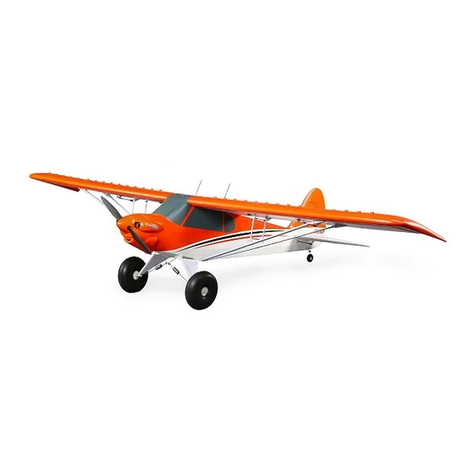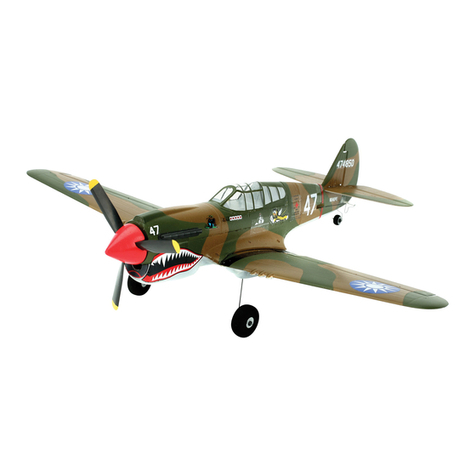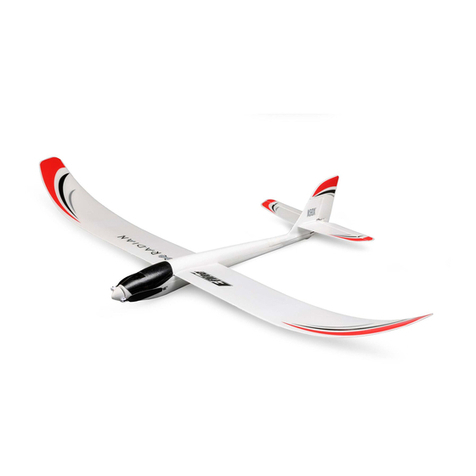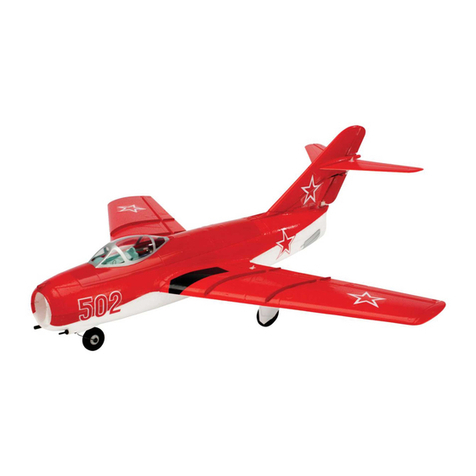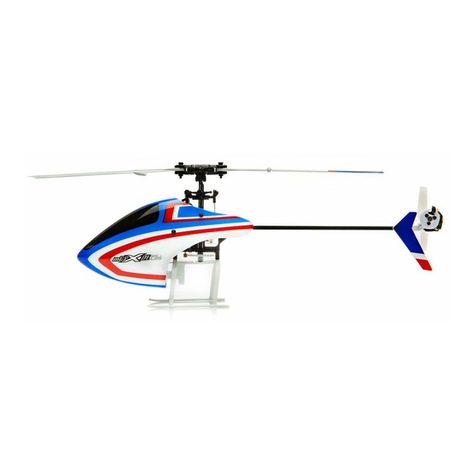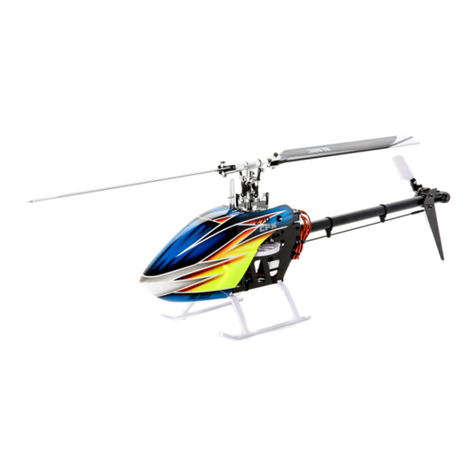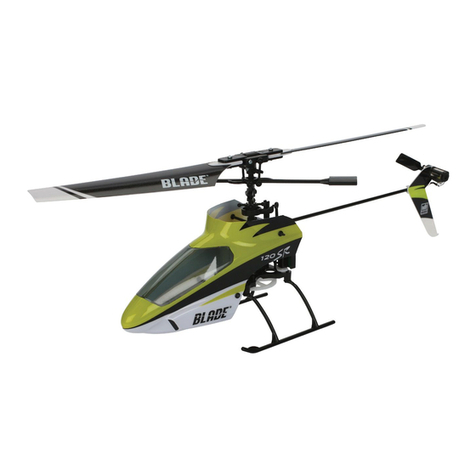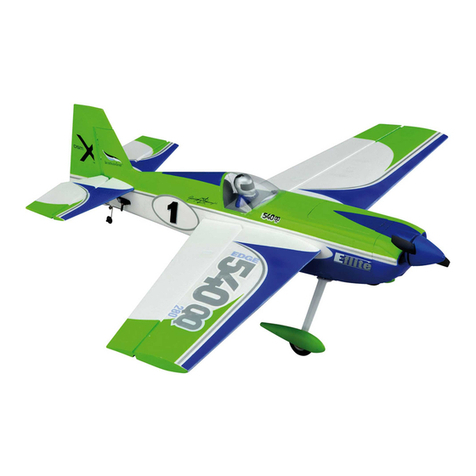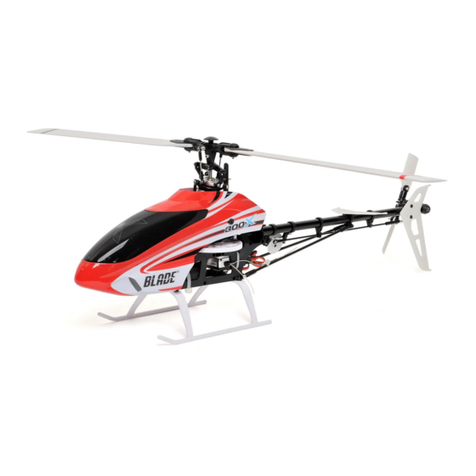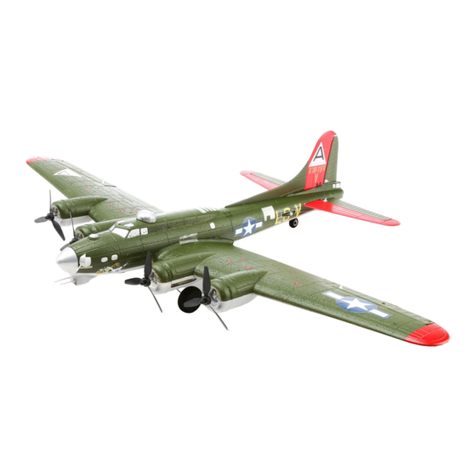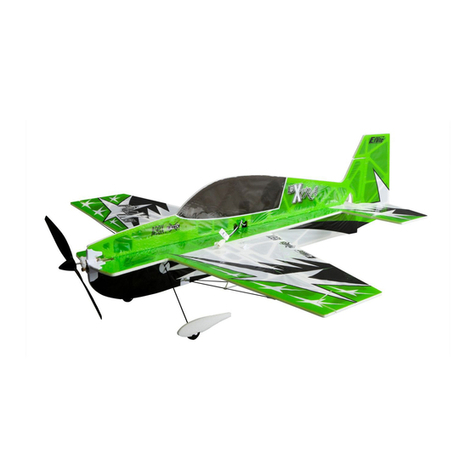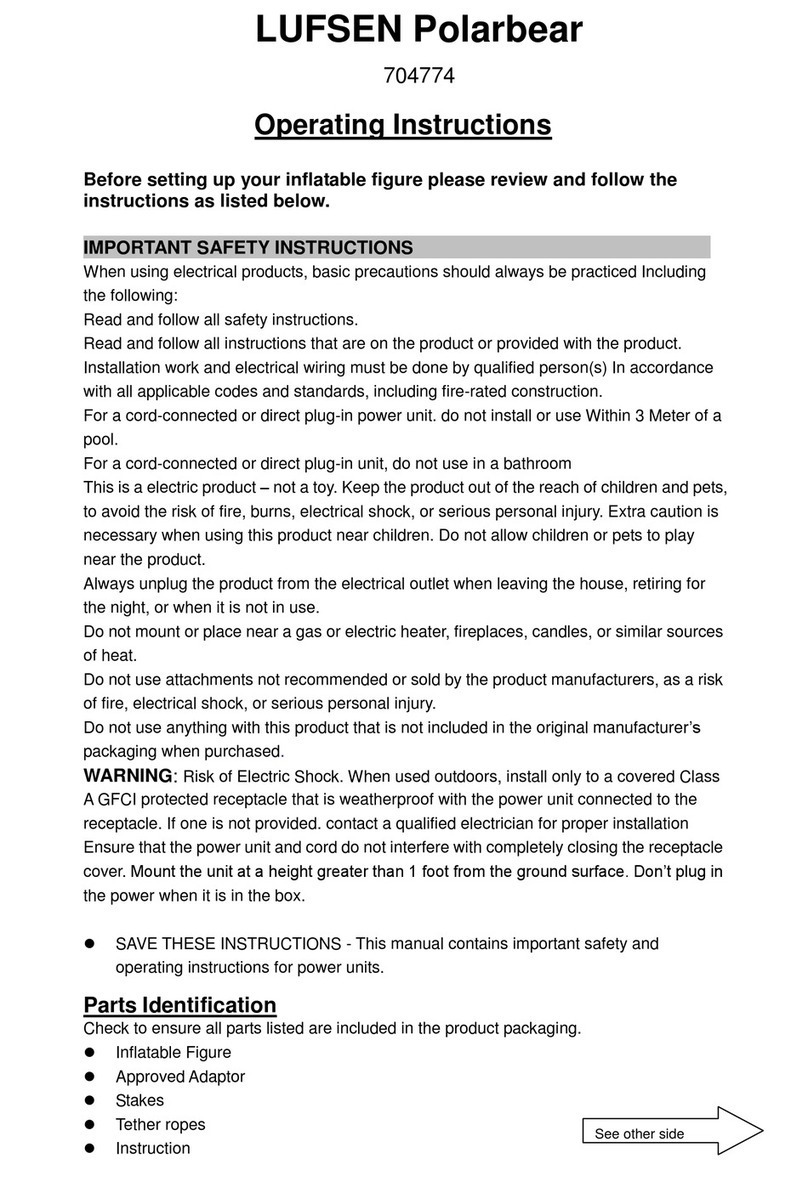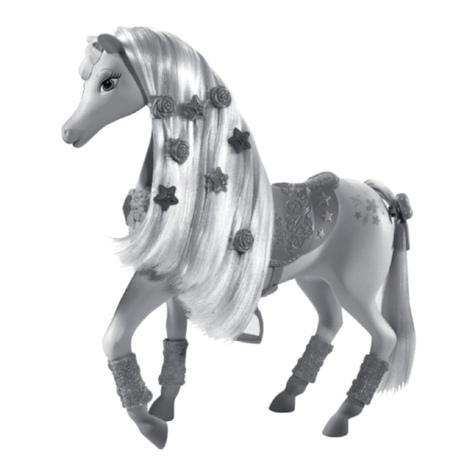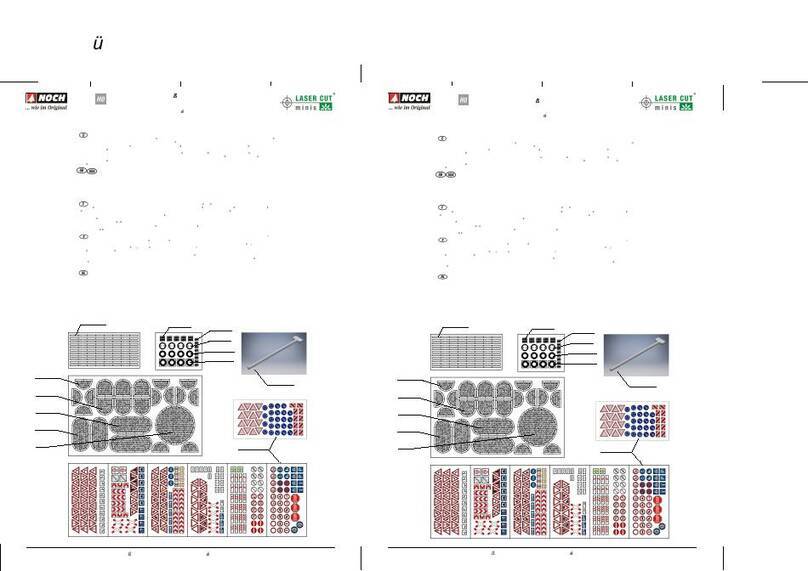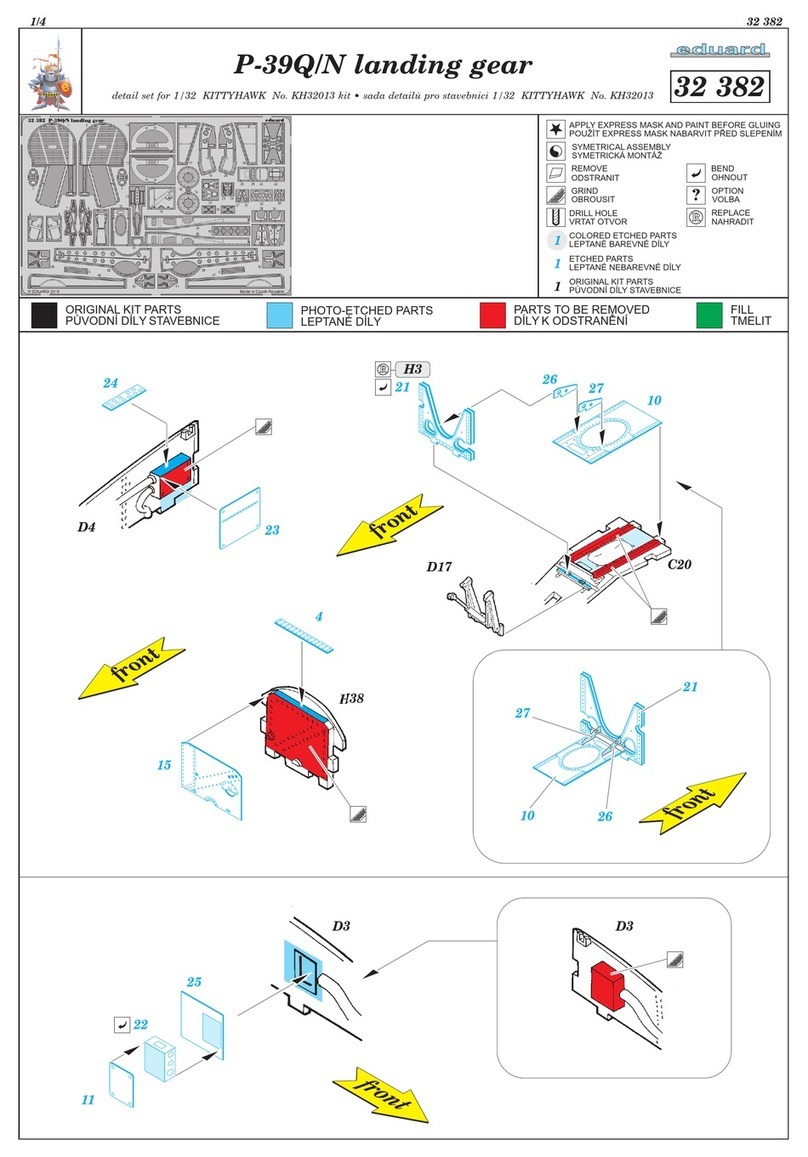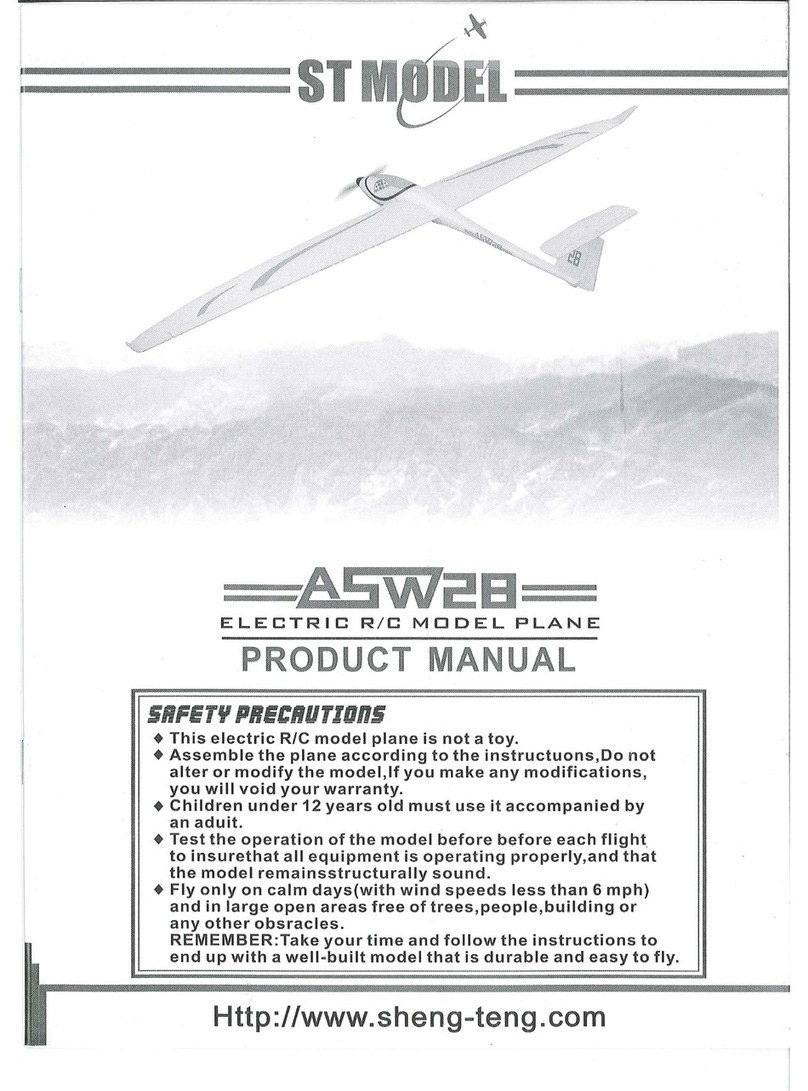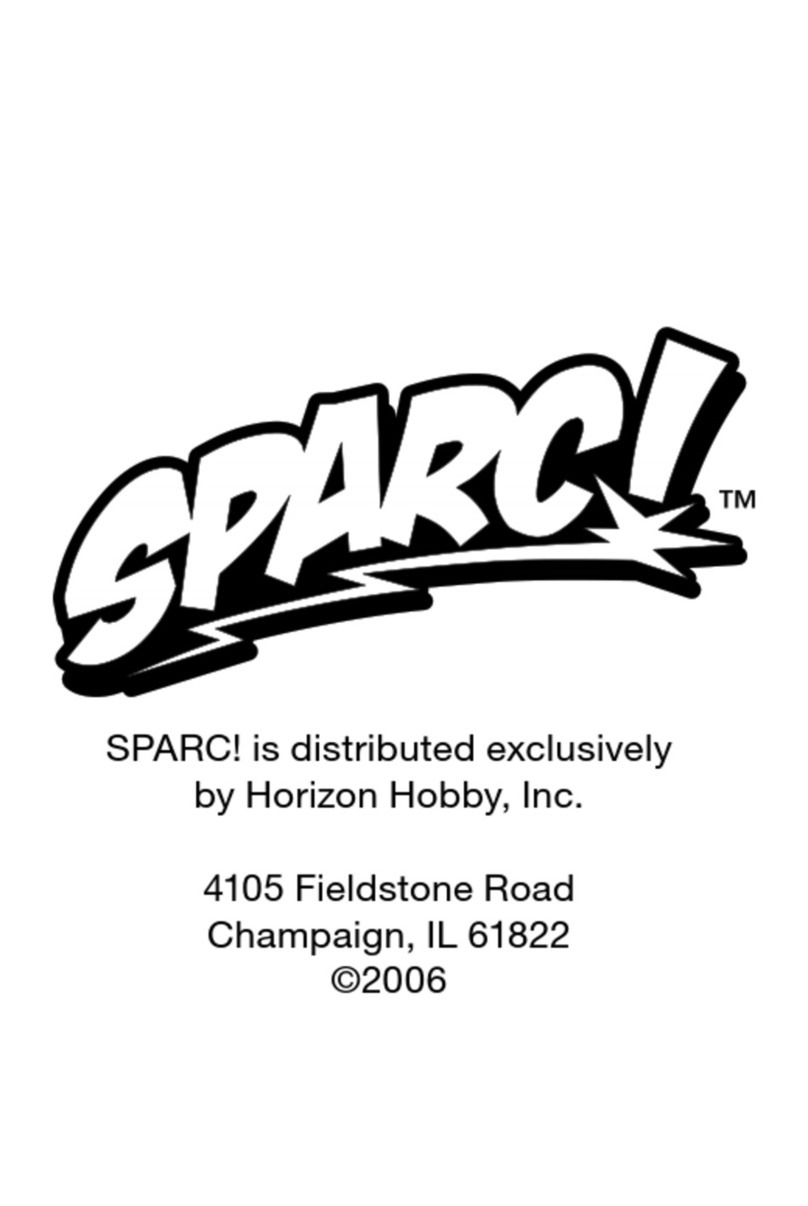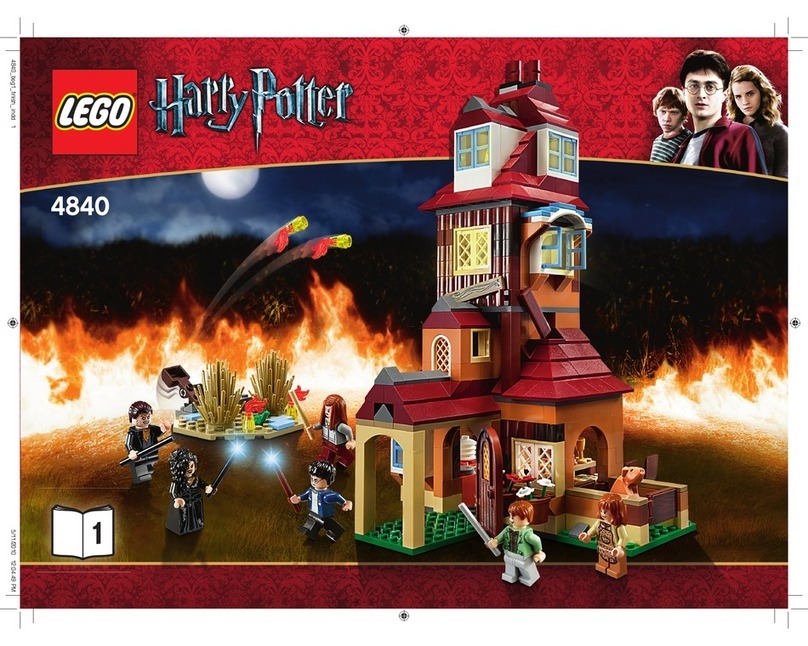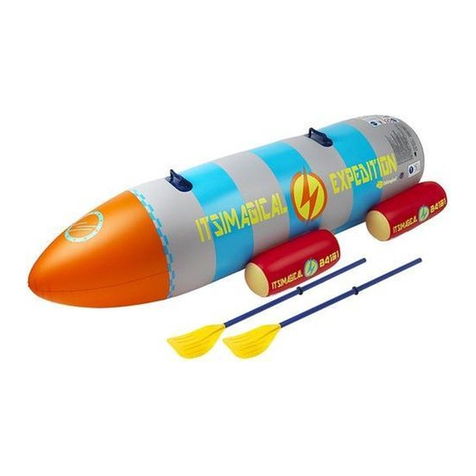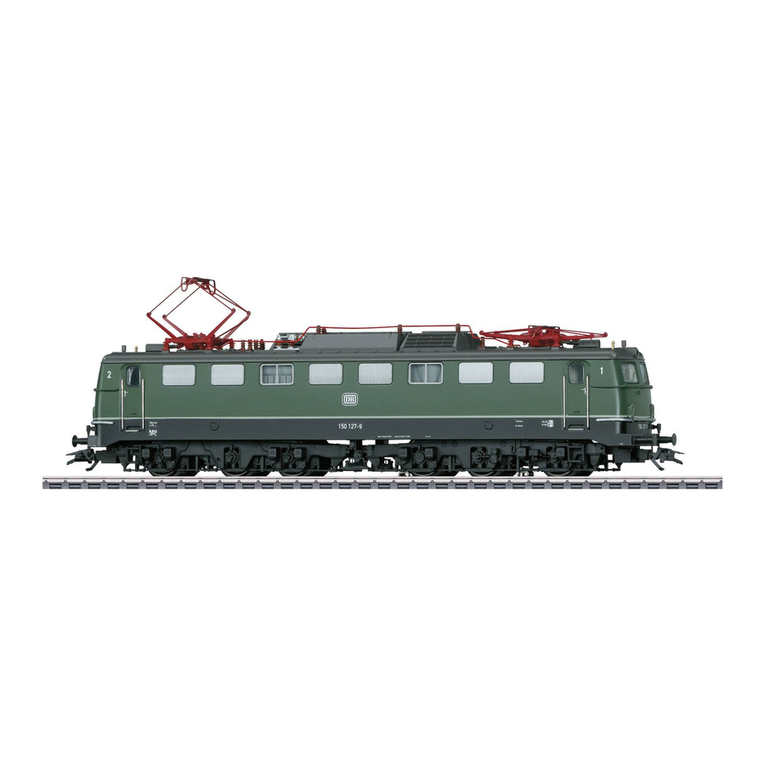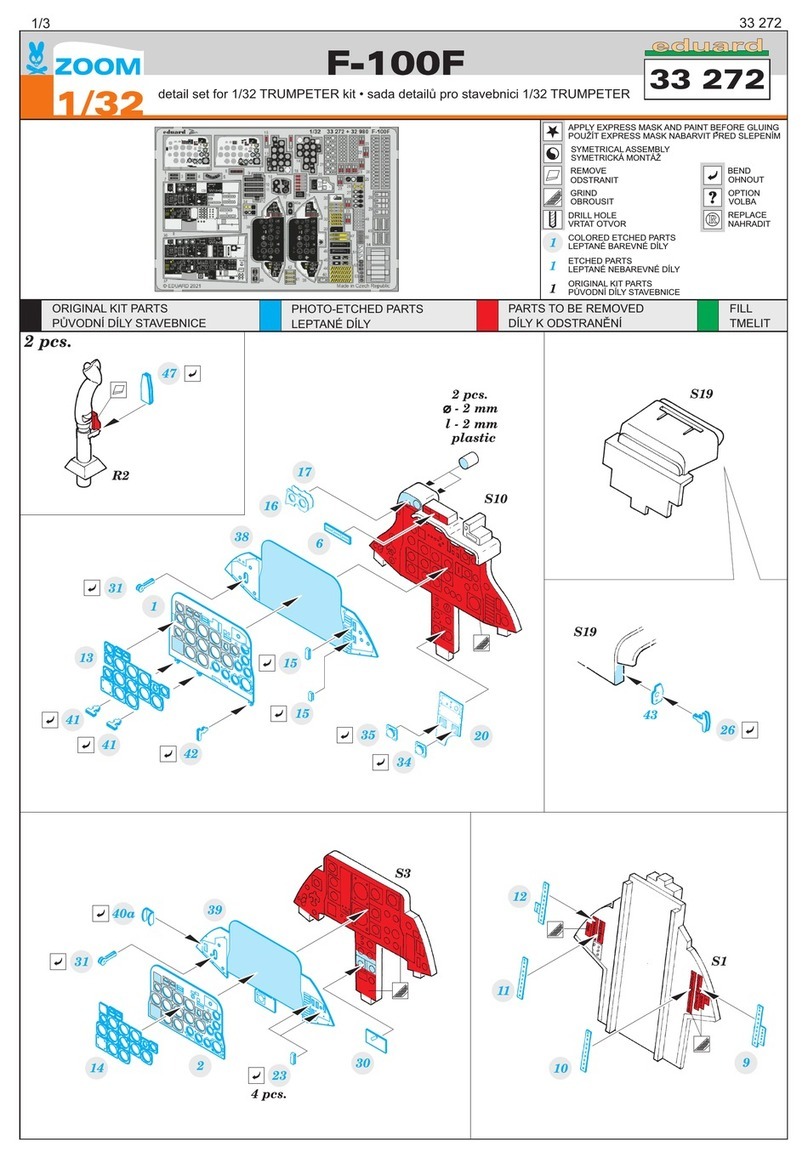BNF INVERZA 280 User manual

Instruction Manual
Bedienungsanleitung
Manuel d’utilisation
Manuale di Istruzioni
INVERZA™280

2
EN
WARNING: Read the ENTIRE instruction manual to become familiar with the features of the
product before operating. Failure to operate the product correctly can result in damage to the product,
personal property and cause serious injury.
This is a sophisticated hobby product. It must be operated with caution and common sense and requires
some basic mechanical ability. Failure to operate this product in a safe and responsible manner could
result in injury or damage to the product or other property. This product is not intended for use by
children without direct adult supervision. Do not use with incompatible components or alter this product
in any way outside of the instructions provided by Horizon Hobby, Inc. This manual contains instructions
for safety, operation and maintenance. It is essential to read and follow all the instructions and warnings
in the manual, prior to assembly, setup or use, in order to operate correctly and avoid damage or
serious injury.
Meaning of Special Language:
The following terms are used throughout the product literature to indicate various levels of potential
harm when operating this product:
NOTICE: Procedures, which if not properly followed, create a possibility of physical property damage AND
little or no possibility of injury.
CAUTION: Procedures, which if not properly followed, create the probability of physical property damage
AND a possibility of serious injury.
WARNING: Procedures, which if not properly followed, create the probability of property damage,
collateral damage, and serious injury OR create a high probability of superficial injury.
NOTICE
All instructions, warranties and other collateral documents are subject to change at the sole discretion
of Horizon Hobby, Inc. For up-to-date product literature, visit www.horizonhobby.com and click on the
support tab for this product.
Age Recommendation: Not for children under
14 years. This is not a toy.
Safety Precautions and Warnings
• Always keep a safe distance in all directions
around your model to avoid collisions or injury.
This model is controlled by a radio signal subject
to interference from many sources outside your
control. Interference can cause momentary loss
of control.
• Always operate your model in open spaces away
from full-size vehicles, traffic and people.
• Always carefully follow the directions and
warnings for this and any optional support equip-
ment (chargers, rechargeable battery packs, etc.).
• Always keep all chemicals, small parts and
anything electrical out of the reach of children.
• Always avoid water exposure to all equipment
not specifically designed and protected for this
purpose. Moisture causes damage to electronics.
• Never place any portion of the model in your
mouth as it could cause serious injury or
even death.
• Never operate your model with low transmitter
batteries.
• Always keep aircraft in sight and under control.
• Always use fully charged batteries.
• Always keep the transmitter powered on while
aircraft is powered.
• Always remove batteries before disassembly.
• Always keep moving parts clean.
• Always keep parts dry.
• Always let parts cool after use before touching.
• Always remove batteries after use.
• Always ensure failsafe is properly set
before flying.
• Never operate aircraft with damaged wiring.
• Never touch moving parts.

3
EN
he E-flite®Inverza™280 Bind-N-Fly®Basic aircraft, designed by world champion Quique Somenzini, has
Tbeen specifically built to provide exceptional precision scale and 3D aerobatic performance so that you
can fly from practically anywhere, such as a park or small field. Everything you love about flying larger,
performance aerobatic airplanes has been packed into the Inverza 280. Beyond its advanced composite-
reinforced foam construction, you’ll appreciate how its expert-approved digital control and custom-tuned
power system components are installed which make it possible for you to get flying fast.
Along with your favorite DSM2®/DSMX®compatible transmitter, you can further assure the value of this
performance model is maintained by considering a quality 11.1V Li-Po flight battery, such as the E-flite
450mAh 3S 11.1V 50C Li-Po, 18AWG JST (EFLB4503SJ50), and a reliable charger, such as the E-flite
Celectra™80W AC/DC Multi-Chemistry Battery Charger (EFLC3025).
Please be sure to read through this manual carefully so that you can successfully enjoy all the benefits this
outstanding E-flite model has to offer.
To register your product online, go to www.e-fliterc.com
Table of Contents
Installed
Motor: BL 280 Outrunner Motor,
1800Kv (EFLM7010)
BL Controller, 10A (EFLA7300)
AR6310 DSMX Nanolite 6Ch Rx, Air
(SPMAR6310)
(3) 3.5 g Digital Servo (EFLR7100)
Needed to Complete
Recommended Battery: 450mAh 3S
11.1V 50C Li-Po, 18AWG JST
(EFLB4503SJ50)
Recommended Battery Charger:
Celectra™80W AC/DC Multi-Chemistry
Battery Charger (EFLC3025)
Recommended Transmitter: Full Range
DSM2®/DSMX®technology with adjustable
Dual rate and exponential (DX6I and up)
26 in (660mm)
26 in (660mm)
8.3oz
(235 g)
Box Contents
Low Voltage Cutoff (LVC).......................................4
Transmitter and Receiver Binding .........................4
Preflight Checklist.................................................4
Installing the Flight Battery ..................................5
Arming the ESC ....................................................6
Installing the Wing ................................................7
Control Direction Test ...........................................8
Control Centering .................................................8
Settings for Servo Arms ........................................8
Dual Rates and Expos ...........................................9
Adjusting Center of Gravity (CG) ..........................10
Removing the Landing Gear................................11
Flying Tips and Repairs.......................................12
Post Flight Checklist ...........................................12
Service of Power Components ............................13
Troubleshooting Guide ........................................14
Limited Warranty ................................................15
Warranty and Service Information.......................16
Compliance Information for the European Union..16
Replacement Parts..............................................62
Optional Replacement and Accessories...............63
Parts Contact Information ...................................63
Specifications

4
EN
Preflight Checklist
1. Charge flight battery.
2. Install flight battery in aircraft
(once it has been fully
charged).
3. Bind aircraft to transmitter.
4. Make sure linkages move
freely.
5. Perform Control Direction
Test with transmitter.
6. Adjust center of gravity.
7. Perform a radio system
Range Check.
8. Find a safe and open area.
9. Plan flight for flying field
conditions.
Low Voltage Cutoff (LVC)
When a Li-Po battery is discharged below 3V per cell, it
will not hold a charge. The aircraft’s ESC protects the flight
battery from over-discharge using Low Voltage Cutoff (LVC).
Once the battery discharges to 3V per cell, the LVC will
reduce the power to the motor in order to leave adequate
power to the receiver and servos to land the airplane.
When the motor power decreases, land the aircraft
immediately and replace or recharge the flight battery.
Always disconnect and remove the Li-Po battery from the
aircraft after each flight. Charge your Li-Po battery to about
half capacity before storage. Make sure the battery charge
does not fall below 3V per cell. Failure to unplug a connected
battery will result in trickle discharge.
For your first flights, set your transmitter timer or a stopwatch
to 5 minutes. Adjust your timer for longer or shorter flights
once you have flown the model. Flights of 7 minutes are
achievable if using proper throttle management.
NOTICE: Repeated flying to LVC will damage the battery.
Binding Procedure
1. Refer to your transmitter’s unique instructions for binding to a
receiver (location of transmitter’s Bind control).
2. Make sure the flight battery is disconnected from the aircraft.
3. Power off the transmitter.
4. Bind the AR6310 receiver to a DSM2/DSMX transmitter by
shorting the bind pins (A) with tweezers, a hemostat or small
needle-nose pliers. Metal to metal contact is needed to com-
plete the circuit. Do not bend the bind pins.
5. Connect the flight battery to the aircraft. Short the pins until
the receiver LED begins to flash rapidly (typically after 5
seconds).
6. Ensure that control surface trims are centered and the throttle
and throttle trims are in the low position to correctly set the
failsafe.
7. Put your transmitter into bind mode. Refer to your transmit-
ter’s manual for binding button or switch instructions.
8. After 5 to 10 seconds, the receiver status LED will become
solid, indicating that the receiver is bound to the transmitter. If
the LED does not turn solid, refer to the Troubleshooting Guide
at the back of the manual.
Binding is the process of programming the receiver to
recognize the GUID (Globally Unique Identifier) code of a
single specific transmitter. You need to ‘bind’ your chosen
Spektrum™DSM2/DSMX technology equipped aircraft
transmitter to the receiver for proper operation.
Any full range Spektrum DSM2/DSMX transmitter can bind to
the DSM2/DSMX receiver. Please visit www.bindnfly.com for a
complete list of compatible transmitters.
Transmitter and Receiver Binding
A
CAUTION: When using a Futaba
transmitter with a Spektrum DSM®
module, you must reverse the throttle
channel and rebind. Refer to your
Spektrum module manual for binding and
failsafe instructions. Refer to your Futaba
transmitter manual for instructions on
reversing the throttle channel.

5
EN
Installing the Flight Battery
1. Remove the battery hatch from the nose of
the aircraft.
2. Apply the included strip of hook and loop tape
in the center on the bottom of your battery.
3. For the recommended CG, install the battery
centered in the compartment, then press the
battery onto the hook and loop strip (A). See
the Adjusting the Center of Gravity instructions
for more information.
4. Connect a fully charged flight battery to the
ESC. See the Arming the ESC instructions for
correct connection of the battery to the ESC.
5. Reinstall the battery hatch.
CAUTION: Always disconnect the Li-Po
battery from the ESC when not flying to eliminate
power supplied to the motor. The ESC does not have
an arming switch and will respond to any
transmitter input when a signal is present.
CAUTION: Always disconnect the Li-Po
battery from the ESC when not flying to avoid
over-discharging the battery. Batteries discharged
to a voltage lower than the lowest approved voltage
may become damaged, resulting in loss of
performance and potential fire when batteries
are charged.
A

6
EN
Arming the ESC
Arming the ESC also occurs after binding as
previously described, but subsequent connection of
a flight battery requires the steps to the right.
Tip: If the ESC sounds a continuous double beep
after the flight battery is connected, recharge or
replace the battery.
If you accidentally connect the battery while the
throttle is fully opened, a musical tone will sound
after 5 seconds and the ESC will enter programming
mode. Disconnect the battery immediately.
CAUTION: Always keep hands away from the
propeller. When armed, the motor will turn the
propeller in response to any throttle movement.
Lower throttle and throttle trim to lowest
settings.
Power on the Transmitter.
1
Remove the magnetic battery hatch and
install the flight battery to the hook and
loop strip, then connect the battery to the
ESC, noting proper polarity.
2
Series of tones
Continuous LED
3

7
EN
1. Slide the wing tube into the right wing.
2. Insert the right wing with the wing tube (A)
into the round hole in the wing slot of
the fuselage while connecting the right
aileron control.
NOTICE: When disconnecting the servo
connectors, do not pull on the servo wires.
Use a screwdriver or pliers to break the friction
fit of the servo connectors. Failure to do so
could result in damage to the servo wiring.
3. Install the left wing (B) by sliding it over
the wing tube to the fuselage while
connecting the left aileron control.
4. Invert the fuselage so the landing gear is
facing up. Secure the left and right wing to
the fuselage using the included screws (C).
5. Remove the receiver cover (D) from the
bottom of the fuselage.
6. Connect the aileron servos in the wings
to the Y-harness connectors in the
fuselage. The left and right aileron
servos can be connected to either side
of the Y-harness.
Tip: If you are using dual aileron/flaperon
transmitter programming, connect the aileron
servo connectors to the AILE and AUX1 ports on
the receiver instead of using the
included Y-harness.
After connecting the servos to the separate
ports, program your transmitter for dual aileron/
flaperon and differential to benefit from the high
performance characteristics of this aircraft.
A
Installing the Wing
B
C
D

8
EN
Control Centering
Before the first flights, or in the event of an ac-
cident, make sure the flight control surfaces are
centered. Adjust the linkages mechanically if the
control surfaces are not centered.
1. Make sure the control surfaces are neutral
when the transmitter controls and trims are
centered. The transmitter sub-trim must
always be set to zero.
2. When needed, use a pair of pliers to carefully
bend the metal linkage (see illustration).
3. Make the U-shape narrower to make the
connector shorter. Make the U-shape wider
to make the linkage longer.
Centering Controls After First Flights
If the model requires excessive transmitter trim,
return the transmitter trim to zero and adjust the
linkages mechanically so that the control surfaces
are in the flight trimmed position.
Settings for Servo Arms
This illustration shows the factory settings for
linkages on servo arms. After flying, you may
choose to adjust the linkage positions for the
desired control response.
This illustration shows the factory setting for the
Elevator servo arm on the servo.
Control Direction Test
You should bind your aircraft and transmitter
before doing these tests. Move the controls on
the transmitter to make sure the aircraft control
surfaces move correctly and in the proper direction.
Make sure the tail linkages move freely and that
paint or decals are not adhered to them.
Ailerons Elevator/Rudder
Elevator servo arm
IMPORTANT: The factory setting for the elevator
servo arm is one tooth forward from a 90°
angle to allow equal elevator deflection up
and down. All other control surface servo arms
should be set to 90°.

9
EN
Dual Rates and Expos
We recommend using a DSM radio capable of
dual rates and expo. The settings to the right are
recommended starting settings for intermediate
pilots. Adjust according to individual preferences
after the initial flight.
Tip: For the first flight, fly the model at LOW RATE.
For more information, videos and
advanced settings for expert pilots, (including
Quique explaining how to fly the EFL Inverza
aircraft), visit www.E-fliteRC.com/Inverza.
Also available for download are Quique’s DX8,
DX7s and DX18 programs for this aircraft. This
programming is at an expert level and includes
some mixing and differential.
Measuring Control Throws
Below are the locations on this aircraft to
measure the recommended low and high
rate control throws (distance) in both
directions.
Rudder:
From the center line (A) deflect the leading
edge of the rudder (B).
Elevator:
From the center line (C) deflect the trailing
edge of the elevator (D).
Ailerons:
From the center line guide (E) deflect the
trailing edge of the aileron (F).
B
A
C
D
F
E
High Rate Low Rate
Dual Rates
Aileron 25mm / 12mm /
Elevator 35mm / 7mm /
Rudder 20mm / 10mm /
Expo
Aileron 40% 30%
Elevator 60% 20%
Rudder 35% 20%

10
EN
Adjusting Center of Gravity (CG)
The CG location is 77mm from the trailing edge of
the wing tip.
The battery compartment is oversized to allow for
Center of Gravity adjustment. Start by centering
the battery in the battery compartment. Adjust as
needed by sliding the battery forward or back.
77mm

11
EN
Removing the Landing Gear
B
B
A
C
1. Remove the 4 screws (A), fairings (B) and
covers (C) from the fuselage.
2. Push the landing gear struts together and
pull away from the fuselage to remove the
landing gear.
Assemble in reverse order.

12
EN
Consult local laws and ordinances before
choosing a location to fly your aircraft.
We recommend flying your aircraft outside in no
greater than moderate winds.
Always avoid flying near houses, trees, wires and
buildings. You should also be careful to avoid flying
in areas where there are many people, such as busy
parks, schoolyards or soccer fields.
Takeoff
Place the aircraft in position for takeoff (facing into
the wind). Set dual rates to LOW POSITION and
gradually increase the throttle to ¾ to full and steer
with the rudder. Pull back gently on the elevator and
climb to check trim. Once the trim is adjusted, begin
exploring the flight envelope of the aircraft.
Flying
This aircraft is extremely responsive to control
input. Fly at low rate settings until you are familiar
with its response.
Fly your first attempts at high rate settings at high
altitude and slow speeds.
Landing
Make sure to land into the wind. Fly the aircraft to
approximately 36 inches (90 cm) or less above the
runway, using a small amount of throttle for the
entire descent. Keep the throttle on until the aircraft
is ready to flare. During flare, keep the wings level
and the aircraft pointed into the wind. Gently lower
the throttle while pulling back on the elevator to
bring the aircraft down on its wheels.
NOTICE: If a crash is imminent, reduce the throttle
and trim fully. Failure to do so could result in extra
damage to the airframe, as well as damage to the
ESC and motor.
NOTICE: Crash damage is not covered under
warranty.
Repairs
Repair this aircraft using foam-compatible CA
(cyanoacrylate adhesive) glue or clear tape. Only use
foam-compatible CA glue as other types of glue can
damage the foam.
When parts are not repairable, see the Replacement
Parts List for ordering by item number.
For a listing of all replacement and optional parts,
refer to the list at the back of this manual.
NOTICE: Use of foam-compatible CA accelerant on
your aircraft can damage paint. DO NOT handle the
aircraft until accelerant fully dries.
NOTICE: When you are finished flying, never keep
the aircraft in the sun. Do not store the aircraft in
a hot, enclosed area such as a car. Doing so can
damage the foam.
Flying Tips and Repairs
Wind
Post Flight Checklist
1. Disconnect flight battery from ESC
(Required for safety and battery life).
2. Power off transmitter.
3. Remove flight battery from aircraft.
4. Recharge flight battery.
5. Store flight battery apart from aircraft
and monitor the battery charge.
6. Make note of flight conditions and
flight plan results, planning for future
flights.

13
EN
Service of Power Components
B
Disassembly
CAUTION: Always disconnect the battery
before handling or adjusting the propeller
or motor. Failure to do so could result in
personal injury.
Propeller
1. Remove the 2 screws (A) from the spinner (B).
Carefully separate the spinner from the back
plate (C).
2. Remove the lock nut (D) from the propeller
shaft (E), then remove the propeller (F) and
back plate.
Motor and Firewall
1. Carefully remove the cowling (G) from the
fuselage. Paint may hold the cowling on the
fuselage.
2. Loosen the set screws (H) and remove the
washer (I) before removing the propeller shaft
from the motor (J).
3. Remove the 4 screws (K) and motor mount (L)
from the fuselage.
4. Disconnect the motor wires from the ESC.
5. Loosen the set screws (M) and remove the
motor from the motor mount.
Assemble in reverse order.
Assembly Tips
• Correctly align and connect the motor wire
colors with the ESC wires.
• The propeller size numbers (6.8 x 3.5) must face
out from the motor for correct propeller operation.
• Ensure the spinner is fully connected to the
spinner back plate for safe operation.
A B
D
FC
E
G
HIJ
KL M
M

14
EN
Problem Possible Cause Solution
Aircraft will
not respond to
throttle but re-
sponds to other
controls
ESC did not arm because throttle stick and/or
throttle trim too high Lower throttle stick and throttle trim to lowest
setting
Throttle channel is reversed Reverse throttle channel on transmitter
Motor disconnected from ESC Make sure motor is connected to the ESC
Servo travel set up is less than 100% Adjust servo travel to 100% or slightly greater
Extra propeller
noise or extra
vibration
Damaged propeller, spinner or motor Replace damaged parts
Prop nut is too loose Tighten the prop nut
Prop is out of balance Remove and balance propeller, or replace with
a balanced propeller
Spinner is not tight or fully seated in place Tighten the spinner or remove the spinner and
turn it 180 degrees
Reduced flight
time or aircraft
underpowered
Flight battery charge is low Completely recharge flight battery
Propeller installed backwards Install propeller properly
Flight battery damaged Replace flight battery and follow flight battery
instructions
Flight battery is too cold Make sure battery is warm before use
Battery capacity too low for flight conditions Replace battery or use a larger capacity battery
Aircraft will not
Bind (during
binding) to trans-
mitter
Transmitter too near aircraft during binding process Power off transmitter, move transmitter a
larger distance from aircraft, disconnect and
reconnect flight battery to aircraft and follow
binding instructions
Bind switch or button not held long enough during
bind process Power off transmitter and repeat bind process.
Hold transmitter bind button or switch until
receiver is bound
Flight battery/Transmitter battery charge is too low Replace/recharge batteries
Bind pins on receiver are not correctly
connected Connect receiver bind pins as instructed and
bind transmitter to receiver
Aircraft or transmitter is too close to large metal
object, wireless source or another transmitter Move aircraft and transmitter to another
location and attempt binding again
Aircraft will not
connet (after
binding) to trans-
mitter
Transmitter too close to aircraft during connecting
process Power off transmitter, move transmitter a
larger distance from aircraft, disconnect and
reconnect flight battery to aircraft
Flight battery/Transmitter battery charge is too low Replace/recharge batteries
Aircraft bound to different model memory
(ModelMatch™ radios only) Select correct model memory on transmitter
Transmitter may have been bound using different
DSM protocol Bind aircraft to transmitter
Bind pins on receiver are connected Ensure bind pins on receiver are not connected
Aircraft or transmitter is too close to large metal
object, wireless source or another transmitter Move aircraft and transmitter to another loca-
tion and attempt connecting again
Control surface
does not move Control surface, control horn, linkage or
servo damage Replace or repair damaged parts and adjust
controls
Wire damaged or connections loose Do a check of wires and connections, connect
or replace as needed
Flight battery charge is low Fully recharge flight battery
Control linkage does not move freely Make sure control linkage moves freely
Controls reversed Transmitter settings reversed Adjust controls on transmitter appropriately
Motor power
quickly decreas-
es and increases
then motor loses
power
Battery voltage is down to the point of receiver/ESC
Low Voltage Cutoff (LVC) Recharge flight battery or replace battery that
is no longer performing
Troubleshooting Guide

15
EN
Limited Warranty
What this Warranty Covers
Horizon Hobby, Inc. (“Horizon”) warrants to the original
purchaser that the product purchased (the “Product”) will
be free from defects in materials and workmanship at the
date of purchase.
What is Not Covered
This warranty is not transferable and does not cover
(i) cosmetic damage, (ii) damage due to acts of God,
accident, misuse, abuse, negligence, commercial
use, or due to improper use, installation, operation or
maintenance, (iii) modification of or to any part of the
Product, (iv) attempted service by anyone other than
a Horizon Hobby authorized service center, (v) Product
not purchased from an authorized Horizon dealer, or
(vi) Product not compliant with applicable technical
regulations.
OTHER THAN THE EXPRESS WARRANTY ABOVE, HORIZON
MAKES NO OTHER WARRANTY OR REPRESENTATION, AND
HEREBY DISCLAIMS ANY AND ALL IMPLIED WARRANTIES,
INCLUDING, WITHOUT LIMITATION, THE IMPLIED
WARRANTIES OF NON-INFRINGEMENT, MERCHANTABILITY
AND FITNESS FOR A PARTICULAR PURPOSE. THE
PURCHASER ACKNOWLEDGES THAT THEY ALONE HAVE
DETERMINED THAT THE PRODUCT WILL SUITABLY MEET
THE REQUIREMENTS OF THE PURCHASER’S INTENDED
USE.
Purchaser’s Remedy
Horizon’s sole obligation and purchaser’s sole and
exclusive remedy shall be that Horizon will, at its option,
either (i) service, or (ii) replace, any Product determined
by Horizon to be defective. Horizon reserves the right to
inspect any and all Product(s) involved in a warranty claim.
Service or replacement decisions are at the sole discretion
of Horizon. Proof of purchase is required for all warranty
claims. SERVICE OR REPLACEMENT AS PROVIDED
UNDER THIS WARRANTY IS THE PURCHASER’S SOLE AND
EXCLUSIVE REMEDY.
Limitation of Liability
HORIZON SHALL NOT BE LIABLE FOR SPECIAL, INDIRECT,
INCIDENTAL OR CONSEQUENTIAL DAMAGES, LOSS OF
PROFITS OR PRODUCTION OR COMMERCIAL LOSS IN ANY
WAY, REGARDLESS OF WHETHER SUCH CLAIM IS BASED
IN CONTRACT, WARRANTY, TORT, NEGLIGENCE, STRICT
LIABILITY OR ANY OTHER THEORY OF LIABILITY, EVEN IF
HORIZON HAS BEEN ADVISED OF THE POSSIBILITY OF
SUCH DAMAGES. Further, in no event shall the liability
of Horizon exceed the individual price of the Product on
which liability is asserted. As Horizon has no control over
use, setup, final assembly, modification or misuse, no
liability shall be assumed nor accepted for any resulting
damage or injury. By the act of use, setup or assembly, the
user accepts all resulting liability. If you as the purchaser
or user are not prepared to accept the liability associated
with the use of the Product, purchaser is advised to return
the Product immediately in new and unused condition to
the place of purchase.
Law
These terms are governed by Illinois law (without regard to
conflict of law principals). This warranty gives you specific
legal rights, and you may also have other rights which vary
from state to state. Horizon reserves the right to change
or modify this warranty at any time without notice.
WARRANTY SERVICES
Questions, Assistance, and Services
Your local hobby store and/or place of purchase cannot
provide warranty support or service. Once assembly, setup
or use of the Product has been started, you must contact
your local distributor or Horizon directly. This will enable
Horizon to better answer your questions and service
you in the event that you may need any assistance. For
questions or assistance, please visit our website at www.
horizonhobby.com, submit a Product Support Inquiry, or
call 877.504.0233 toll free to speak to a Product Support
representative.
Inspection or Services
If this Product needs to be inspected or serviced and is
compliant in the country you live and use the Product in,
please use the Horizon Online Service Request submission
process found on our website or call Horizon to obtain a
Return Merchandise Authorization (RMA) number. Pack
the Product securely using a shipping carton. Please
note that original boxes may be included, but are not
designed to withstand the rigors of shipping without
additional protection. Ship via a carrier that provides
tracking and insurance for lost or damaged parcels, as
Horizon is not responsible for merchandise until it arrives
and is accepted at our facility. An Online Service Request
is available at http://www.horizonhobby.com/content/_
service-center_render-service-center. If you do not have
internet access, please contact Horizon Product Support
to obtain a RMA number along with instructions for
submitting your product for service. When calling Horizon,
you will be asked to provide your complete name, street
address, email address and phone number where you can
be reached during business hours. When sending product
into Horizon, please include your RMA number, a list of
the included items, and a brief summary of the problem.
A copy of your original sales receipt must be included
for warranty consideration. Be sure your name, address,
and RMA number are clearly written on the outside of the
shipping carton.
NOTICE: Do not ship LiPo batteries to Horizon. If you
have any issue with a LiPo battery, please contact the
appropriate Horizon Product Support office.
Warranty Requirements
For Warranty consideration, you must include your
original sales receipt verifying the proof-of-purchase
date. Provided warranty conditions have been met,
your Product will be serviced or replaced free of charge.
Service or replacement decisions are at the sole discretion
of Horizon.
Non-Warranty Service
Should your service not be covered by warranty,
service will be completed and payment will be
required without notification or estimate of the
expense unless the expense exceeds 50% of the retail
purchase cost. By submitting the item for service you are
agreeing to payment of the service without notification.
Service estimates are available upon request. You must
include this request with your item submitted for service.
Non-warranty service estimates will be billed a minimum
of ½ hour of labor. In addition you will be billed for return
freight. Horizon accepts money orders and cashier’s
checks, as well as Visa, MasterCard, American Express,
and Discover cards. By submitting any item to Horizon

16
EN
Declaration of Conformity
Compliance Information for the European Union
(in accordance with ISO/IEC 17050-1)
No. HH2013032601U1
Product(s): Inverza 280 BNF Basic
Item Number(s): EFL6350
Equipment class: 1
The object of declaration described above is in conformity with the requirements of the specifications listed
below, following the provisions of the European R&TTE directive 1999/5/EC and EMC Directive 2004/108/EC:
EN301 489-1 V1.9.2: 2012
EN301 489-17 V2.1.1: 2009
EN55022:2010 + AC:2011
EN55024:2010
Signed for and on behalf of:
Horizon Hobby, Inc.
Champaign, IL USA
Mar 26, 2013
Steven A. Hall
Executive VP – Chief Operating Officer
International Operations and Risk Management
Horizon Hobby, Inc.
Warranty and Service Information
Country of Purchase Horizon Hobby Address Phone Number/Email Address
United States
of America
Horizon Service Center
(Electronics and engines)
4105 Fieldstone Rd
Champaign, Illinois
61822 USA
877-504-0233
Online Repair Request visit:
www.horizonhobby.com/service
Horizon Product Support
(All other products)
4105 Fieldstone Rd
Champaign, Illinois
61822 USA
877-504-0233
United Kingdom Horizon Hobby Limited
Units 1-4 Ployters Rd
Staple Tye
Harlow, Essex
CM18 7NS, United Kingdom
+44 (0) 1279 641 097
sales@horizonhobby.co.uk
Germany Horizon Technischer
Service
Christian-Junge-Straße 1
25337 Elmshorn, Germany
+49 (0) 4121 2655 100
service@horizonhobby.de
France Horizon Hobby SAS 11 Rue Georges Charpak
77127 Lieusaint, France
+33 (0) 1 60 18 34 90
infofrance@horizonhobby.com
China Horizon Hobby – China Room 506, No. 97 Changshou Rd.
Shanghai, China, 200060
+86 (021) 5180 9868
info@horizonhobby.com.cn
Instructions for disposal of WEEE by users in the European Union
This product must not be disposed of with other waste. Instead, it is the user’s responsibility
to dispose of their waste equipment by handing it over to a designated collections point
for the recycling of waste electrical and electronic equipment. The separate collection and
recycling of your waste equipment at the time of disposal will help to conserve natural
resources and ensure that it is recycled in a manner that protects human health and the
environment. For more information about where you can drop off your waste equipment for recycling, please
contact your local city office, your household waste disposal service or where you purchased the product.
for service, you are agreeing to Horizon’s Terms and
Conditions found on our website http://www.horizonhobby.
com/content/_service-center_render-service-center.
ATTENTION: Horizon service is limited to Product
compliant in the country of use and ownership.
If received, a non-compliant Product will not be
serviced. Further, the sender will be responsible for
arranging return shipment of the un-serviced Product,
through a carrier of the sender’s choice and at the
sender’s expense. Horizon will hold non-compliant
Product for a period of 60 days from notification, after
which it will be discarded.

17
DE
WARNUNG: Lesen Sie die GESAMTE Bedienungsanleitung, um sich vor Inbetriebnahme mit den
Funktionen des Produkts vertraut zu machen. Eine nicht ordnungsgemäße Bedienung des Produkts kann
das Produkts und persönliches Eigentum schädigen und schwere Verletzungen verursachen.
Dies ist ein hoch entwickeltes Produkt für den Hobbygebrauch. Es muss mit Vorsicht und Umsicht be-
dient werden und erfordert einige mechanische Grundfertigkeiten. Wird das Produkt nicht sicher und um-
sichtig verwendet, so könnten Verletzungen oder Schäden am Produkt oder anderem Eigentum entste-
hen. Dieses Produkt ist nicht für den Gebrauch durch Kinder ohne direkte Aufsicht eines Erwachsenen
vorgesehen. Verwenden Sie das Produkt nicht mit inkompatiblen Komponenten oder verändern es in jed-
weder Art ausserhalb der von Horizon Hobby Inc vorgegebenen Anweisungen. Dieses Handbuch enthält
Sicherheitshinweise sowie Anleitungen zu Betrieb und Wartung. Es ist unerlässlich, dass Sie alle Anlei-
tungen und Warnungen in diesem Handbuch vor dem Zusammenbau, der Einrichtung oder der Inbe-
triebnahme lesen und diese befolgen, um eine korrekte Bedienung zu gewährleisten und Schäden bzw.
schwere Verletzungen zu vermeiden.
Begriffserklärung
Die folgende Begriffe werden in der gesamte Produktliteratur verwendet, um die Gefährdungsstufen im
Umgang mit dem Produkt zu definieren:
HINWEIS: Verfahren können bei nicht ordnungsgemäßer Durchführung womöglich Schäden an physi-
schem Eigentum UND geringfügige oder keine Verletzungen verursachen.
ACHTUNG: Verfahren können bei nicht ordnungsgemäßer Durchführung womöglich Schäden an physi-
schem Eigentum UND schwere Verletzungen verursachen.
WARNUNG: Verfahren können bei nicht ordnungsgemäßer Durchführung womöglich Schäden an Eigen-
tum, Kollateralschäden UND schwere Verletzungen ODER höchstwahrscheinlich oberflächliche Verletzun-
gen verursachen.
HINWEIS
Allen Anweisungen, Garantien und anderen zugehörigen Dokumenten sind Änderungen nach Ermessen
von Horizon Hobby, Inc. vorbehalten. Aktuelle Produktliteratur finden Sie unter www.horizonhobby.com
im Support-Abschnitt für das Produkt.
Altersempfehlung: Nicht für Kinder unter 14
Jahren. Dies ist kein Spielzeug.
Warnungen und
Sicherheitshinweise
• Halten Sie immer einen Sicherheitsabstand zu al-
len Seiten um das Modell um Kollisionen oder
Verletzungen zu vermeiden. Dieses Modell wird
von einem Funksignal gesteuert, dass von vielen
Quellen ausserhalb ihrer Kontrolle gestört werden
kann. Diese Störungen können zu momentanen
Kontrollverlust führen.
• Betreiben Sie Ihr Modell stets auf offenen Ge-
länden, weit ab von Automobilen, Verkehr und
Menschen.
• Folgen Sie stets vorsichtig den Anweisungen und
Warnungen für dieses Modell und allem dazuge-
hörigem Zubehör (Ladegeräte, Akkus etc..)
• Halten Sie immer alle Chemikalien, Kleinteile und
alle elektrischen Bauteile aus der Reichweite von
Kindern.
• Vermeiden Sie jeglichen Wasserkontakt mit al-
len Teilen die nicht speziell dafür entwickelt wor-
den und geschützt sind. Feuchtigkeit beschädigt
die Elektronik.
• Nehmen Sie niemals Teile ihres Modells in den
Mund, da das zu schweren Verletzungen bis hin
zum Tot führen könnte.
• Betreiben Sie niemals Ihr Modell mit leeren
Senderbatterien.
• Halten Sie immer ihr Modell in Sicht und unter
Kontrolle.
• Verwenden Sie immer vollständig geladene
Akkus.
• Lassen Sie immer den Sender eingeschaltet wenn
das Luftfahrzeug eingeschaltet ist.
• Entnehmen Sie immer die Akkus vor der
Demontage.
• Halten Sie immer alle beweglichen Teile sauber.
• Halten Sie stets alle Teile sauber.
• Lassen Sie alle Teile abkühlen bevor Sie sie
anfassen.
• Entfernen Sie immer die Akkus nach der
Benutzung.
• Vergewissern Sie sich vor dem Fliegen das die
Failsafeinstellungen korrekt eingestellt sind.
• Betreiben Sie niemals das Flugzeug mit beschä-
digter Verkabelung.
• Fassen Sie niemals bewegte Teile an.

18
DE
Die E-flite Inverza 280 Bind-N-Fly Basic wurde von World Champion Quique Somenzini entwickelt. Sie
bietet außergewöhnliche Präzisionsflug- und 3D Performance und läßt sich auch auf kleinen Flächen
hevorragend fliegen.
Dazu finden Sie alles was Sie an großen Flugzeugen schätzen auch in der Inverza 280. Hinter der fort-
schrittlichen Composite-Schaum Konstruktion werden Sie von dem Custom-designten Hochleistungsantrieb
begeistert sein, der hohe Geschwindigkeiten ermöglicht.
Zusammen mit einem DSM2 / DSMX kompatiblen Sender ihrer Wahl können Sie das Potential der Maschi-
ne mit einem qualitativ hochwertigen 11,1 Volt Flugakku wie den E-flite 450mAh 3S 11.1V 50C Li-Po Akku
(EFLB4503SJ50)und einem Ladegerät wie dem Celectra 80W AC/DC Multi-Akku Ladegerät (EFLC3025) voll
genießen.
Bitte lesen Sie sich diese Bedienungsanleitung sorgfältig durch, so dass Sie erfolgreich die fantastischen
Möglichkeiten dieses außergewöhnlichen E-flite Modells nutzen können.
Registrieren Sie Ihr Produkt im Internet unter www.e-fliterc.com
Inhaltsverzeichnis
Eingebaut
Motor: BL 280 Außenläufer Motor,
1800Kv (EFLM7010)
BL Regler, 10A (EFLA7300)
AR6310 DSMX Nanolite 6-Kanal Emp-
fänger, Air (SPMAR6310)
(3) 3.5 g Digital Servo (EFLR7100)
Wird noch benötigt
Empohlener Akku: 450mAh 3S
11.1V 50C Li-Po, 18AWG JST
(EFLB4503SJ50)
Empfohlenes Ladegerät:
Celectra 80W AC/DC Multi-Akku Lade-
gerät (EFLC3025)
Empfohlener Sender: DSM2 / DSMX
Sender mit voller Reichweite mit einstellbaren
Dual Rate und Exponetial (DX6i und höher)
660mm
660mm
235 g
Lieferumfang
Niederspannungsabschaltung (LVC) ....................19
Binden von Sender und Empfänger.....................19
Vorflugkontrolle ..................................................19
Einsetzen des Flugakkus ....................................20
Armieren des Reglers .........................................21
Montage der Tragfläche ......................................22
Steuerrichtungstest ............................................23
Zentrieren der Ruderflächen ..............................23
Einstellungen die Servoarme...............................23
Dual Rates und Expos.........................................24
Einstellen des Schwerpunktes (CG).....................25
Demontage des Fahrwerks .................................26
Tipps zum Fliegen und Reparieren......................27
Checkliste nach dem Flug...................................27
Wartung der Antriebskomponenten .....................28
Problemlösung....................................................29
Garantie und Serviceinformationen .....................30
Garantie und Service Kontakt Informationen........31
Konformitätshinweise für die Europäische Union.31
Ersatzteile...........................................................62
Optionale Bauteile und Zubehörteile....................63
Kontaktinformationen für Ersatzteile ...................63
Spezifikationen

19
DE
Vorflugkontrolle
1. Laden Sie den Flugakku.
2. Setzen Sie den vollständig gelad-
enen Flugakku in das Flugzeug
ein.
3. Binden Sie den Flugzeugempfän-
ger an den Sender.
4. Stellen Sie sicher, dass sich alle
Anlenkungen frei bewegen kön-
nen.
5. Führen Sie mit dem Sender
einen Steuerkontrolltest durch.
6. Justieren Sie den Schwerpunkt.
7. Führen Sie einen Reichweit-
entest durch.
8. Finden Sie eine sichere und of-
fene Gegend zum fliegen.
9. Planen Sie ihren Flug nach den
Flugfeldbedingungen.
Niederspannungsabschaltung (LVC)
Wird ein LiPo Akku unter 3 Volt pro Zelle entladen kann er ke-
ine Spannung mehr halten. Der Regler schützt den Akku vor
einer Unterspannung mit der Niederspannungsabschaltung
(LVC). Unabhängig von der Gasknüppelstellung wird dann die
Leistung reduziert, um einen Absinken der Zellenspannung
unter 3 Volt zu verhindern.
Der Motor fängt dann an zu pulsieren und zeigt damit an,
dass noch Energie für eine sichere Landung bleibt. Bitte
landen Sie sofort wenn der Motor zu pulsieren anfängt und
laden den Akku wieder auf.
Trennen Sie nach dem Fliegen immer den Akku vom Emp-
fänger und entfernen ihn aus dem Flugzeug. Laden Sie den
Akku auf die halbe Kapazität bevor Sie ihn einlagern. Stellen
Sie bitte sicher, dass die Akkuspannung nicht unter 3 Volt pro
Zelle fällt. Trennen Sie den Akku nicht wird er tiefentladen.
Stellen Sie für die ersten Flüge die Stopuhr oder den Tim-
er auf ihrer Fernsteuerung auf 5 Minuten ein. Stellen Sie
den Timer nach dem ersten Flug länger oder kürzer ein. Bei
gutem Gasmanagement sind 7 Minuten Flugzeit möglich.
HINWEIS: Wiederholtes Fliegen in die Niederspannungs-
abschaltung beschädigt den Akku.
Der Bindevorgang
1. Bitte lesen Sie die Bindeanweisungen ihres Senders. (Position
des Bindeknopfes)
2. Stellen Sie sicher dass der Flugakku vom Regler getrennt ist.
3. Schalten Sie den Sender aus.
4. Binden Sie den AR6310 Empfänger an einen DSM2 Sender
indem Sie die beiden Bindepins (A) mit einer Pinzette,
Spitzzange o.ä. zusammendrücken. Der Metallkontakt ist
notwendig um diesen Vorgang durchzuführen. Verbiegen Sie
die Pins dabei nicht.
5. Schließen Sie den Akku an das Flugzeug an. Drücken Sie die
Pins zusammen bis die Empfänger LED beginnt schnell zu
blinken. (Normalerweise nach 5 Sekunden)
6. Bitte stellen Sie sicher, dass alle Ruder zentriert sind und Gas-
sowie die Gastrimmung in der untersten möglichen Position
sind um so das Failsafe einzustellen.
7. Aktivieren Sie den Binde Mode des Senders. Bitte lesen Sie
dazu in der Bedienungsanleitung des Senders.
8. Nach 5 - 10 Sekunden fängt die Empfänger Status LED an zu
leuchten und zeigt damit an das der Empfänger an den Sender
gebunden ist. Sollte die LED nicht leuchten, sehen Sie bitte in
der Problemlösung auf der Rückseite der Anleitung nach.
Beim Bindeprozess wird der Empfänger programmiert, um
den GUID- (Global eindeutiger Identifikations-) Code eines
einzelnen speziellen Senders zu erkennen. Für einen ord-
nungsgemäßen Betrieb müssen Sie Ihren gewählten Flug-
zeugsender mit Spektrum DSM2/DSMX-Technologie an den
Empfänger „binden“.
Jeder Spektrum DSM2/DSMX Sender kann mit einem DSM2/
DSMX Empfänger gebunden werden. Bitte besuchen Sie www.
bindnfly.com für die vollständige Liste kompatibler Sender.
Binden von Sender und Empfänger
A
ACHTUNG: Wenn Sie einen Futaba
-Sender mit einem Spektrum DSM-Modul
verwenden, müssen Sie den Gaskanal re-
versieren (umkehren) und danach das
System neu binden. Lesen Sie bitte für
den Bindevorgang und programmieren
der Failsafeeinstellungen die Bedienung-
sanleitung des Spektrum Modules. Zum
reversieren des Gaskanals lesen Sie bitte
in der Anleitung des Futaba Senders nach.

20
DE
Einsetzen des Flugakkus
1. Nehmen Sie Akkuklappe vorne vom Rumpf ab.
2. Kleben Sie das im Lieferumfang enthaltene
Klettband wie abgebildet auf die Unterseite des
Akkus in der Nähe der Anschlußkabel. Diese
Position ermöglicht einfaches Einsetzen und
Entnehmen des Akkus.
3. Setzen Sie für den empfohlenen Schwerpunkt
den Akku in der Mitte des Akkufaches ein und
drücken ihn auf dem Klettstreifen (A) fest.
Lesen Sie für mehr Informationen den Abschnitt
Einstellen des Schwerpunktes.
4. Schließen Sie den vollständig geladenen Akku
an den Regler an. Bitte sehen Sie für den kor-
rekten Anschluß des Akkus an den Regler unter
dem Abschnitt Armieren des Reglers nach.
5. Setzen Sie die Akkuklappe wieder auf.
ACHTUNG: Trennen Sie immer den Flugakku
vom Regler wenn Sie nicht fliegen um die Stromver-
sorgung zu unterbrechen. Der Regler hat keinen
Ein/Aus Schalter und reagiert auf jede Knüppeleing-
abe bei bestehendem Signal.
ACHTUNG: Trennen Sie immer den LiPo Akku
vom Flugzeug wenn Sie nicht fliegen um ein tiefent-
laden des Akkus zu vermeiden. Akkus die unter die
zulässige Mindestspannung entladen werden, kön-
nen beschädigt werden was zu Leistungsverlust
und potentieller Brandgefahr bei dem Laden führen
kann.
A
Table of contents
Languages:
Other BNF Toy manuals
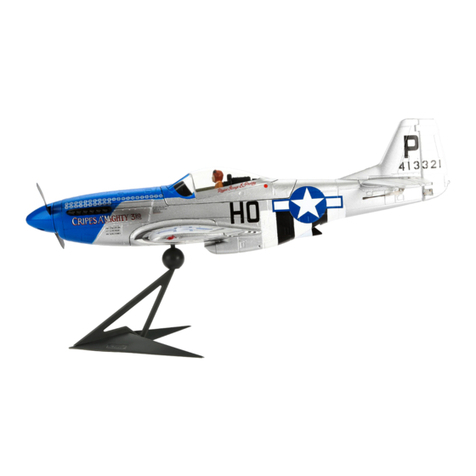
BNF
BNF P-51D Mustang 280 User manual
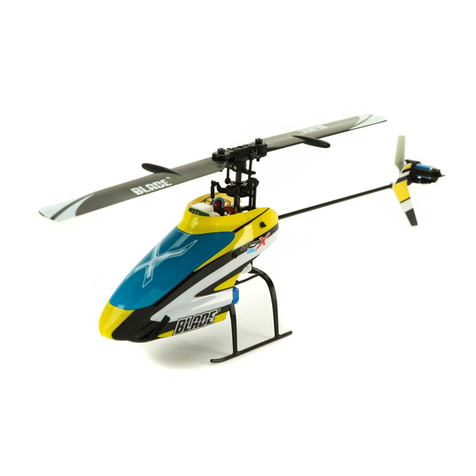
BNF
BNF Blade MCP X BL User manual
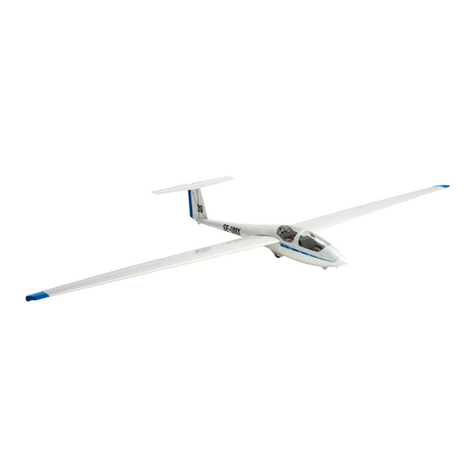
BNF
BNF E-FLITE UMX ASK-21 User manual
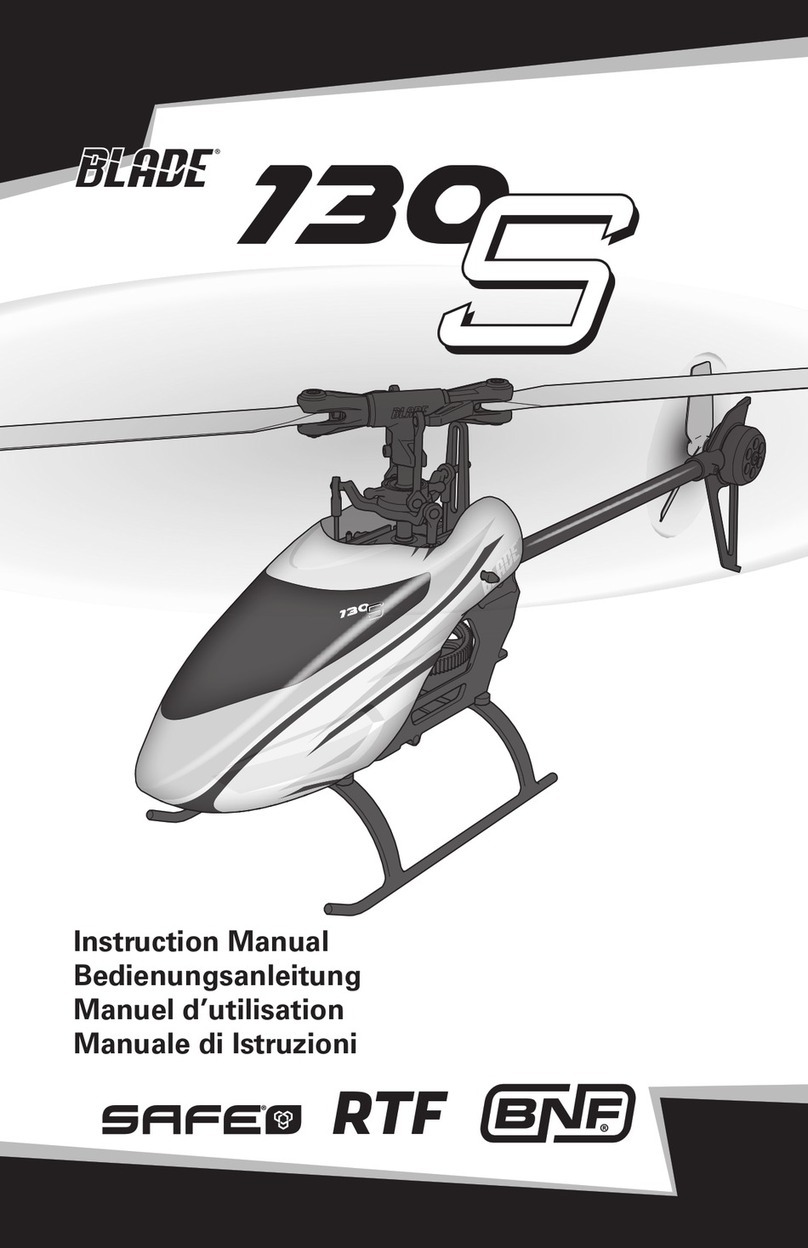
BNF
BNF Blade 130 S User manual

BNF
BNF Viking 12 280 User manual
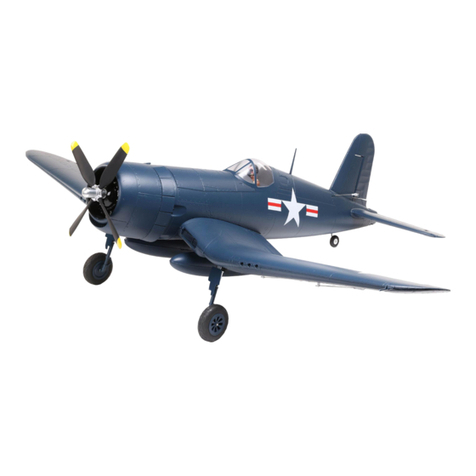
BNF
BNF F4U-1A Corsair User manual

BNF
BNF BLADE 450 X User manual
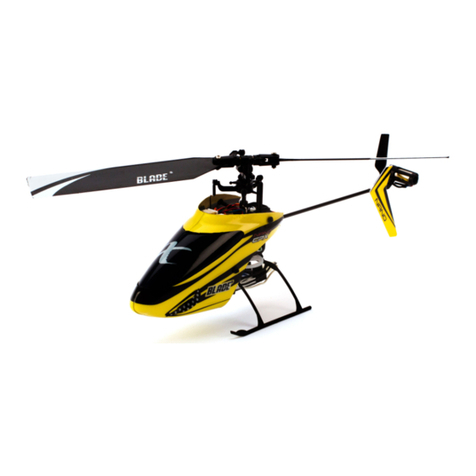
BNF
BNF Blade Nano CPX User manual

BNF
BNF Blade 500 3D User manual
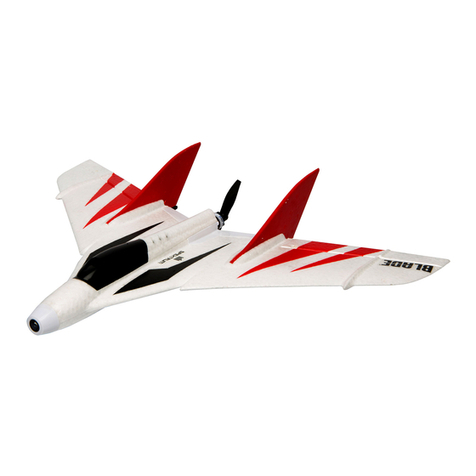
BNF
BNF BLADE UMX F27 FPV User manual


